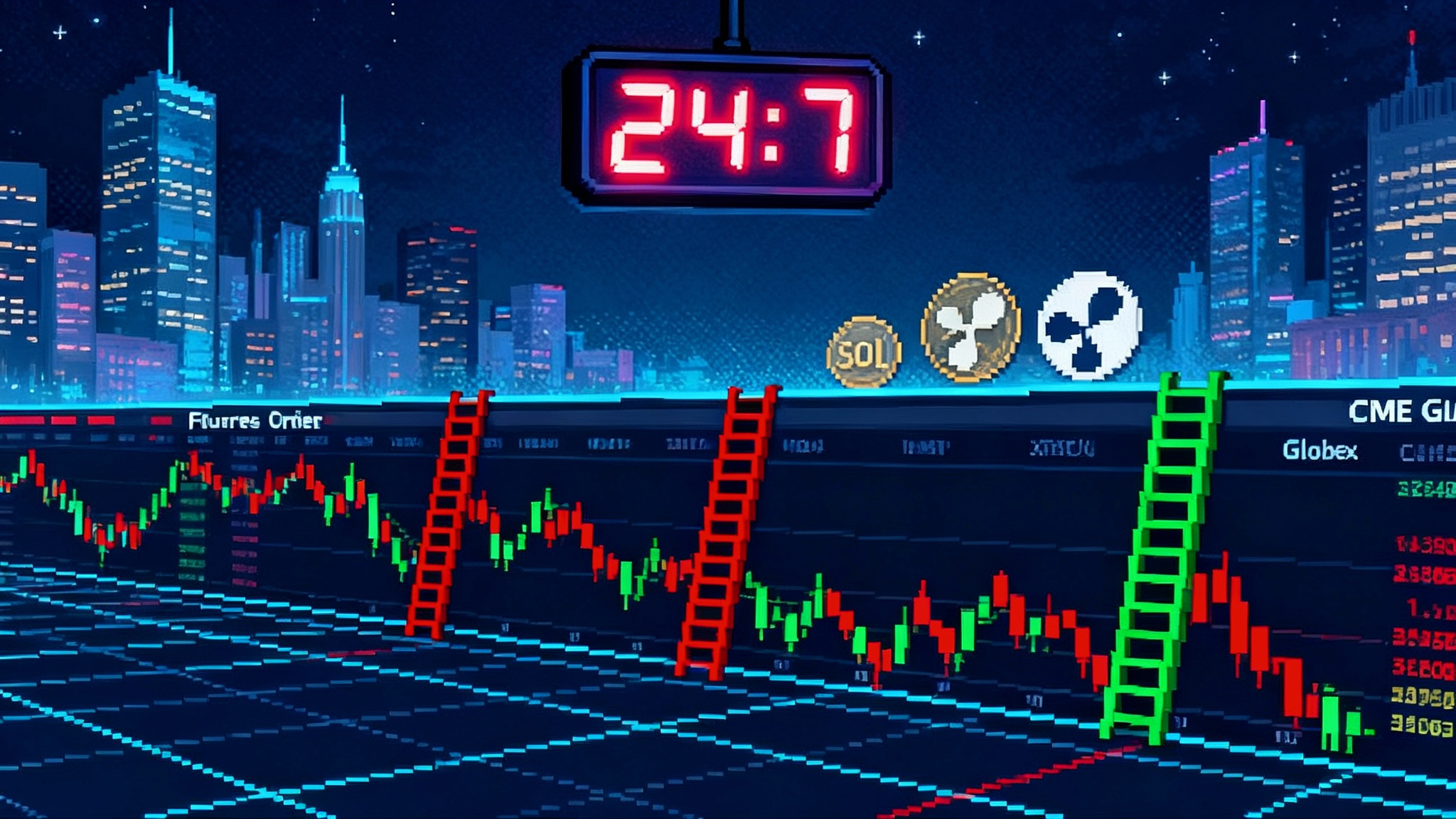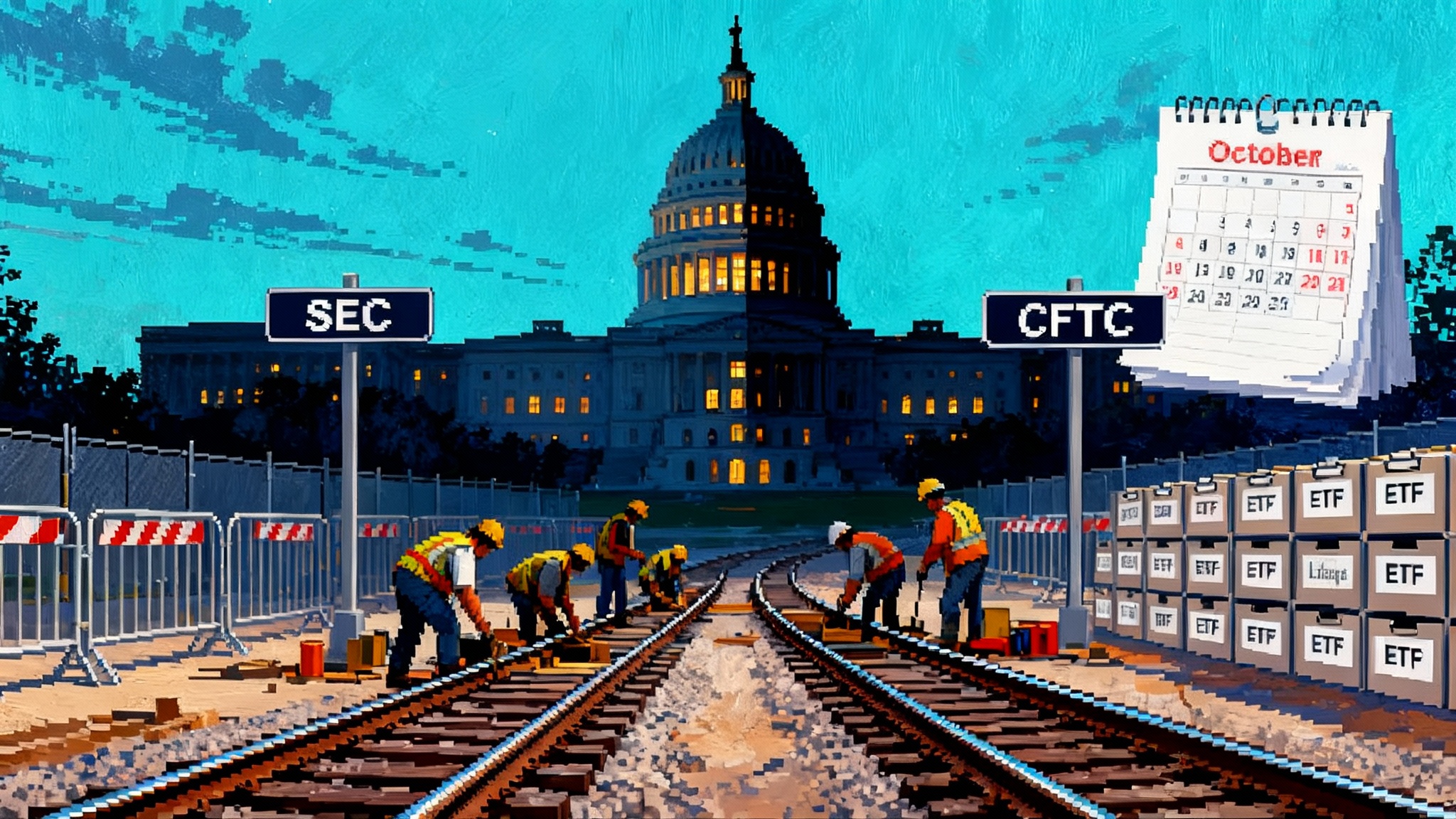CME goes crypto native with 24/7 access and SOL XRP options
A top U.S. derivatives venue is moving to always‑on crypto trading and has launched options on Solana and XRP. Here is how continuous, regulated derivatives can tighten weekend spreads, deepen liquidity, and reshape basis and volatility markets.

The moment crypto market structure turns a corner
A big switch just flipped in U.S. market plumbing. CME Group, the dominant regulated derivatives exchange, announced in an October 2, 2025 announcement that its cryptocurrency futures and options will be tradable 24 hours a day, seven days a week beginning in early 2026, pending regulatory review. That plan breaks from the traditional Sunday evening to Friday evening schedule and aligns listed products with crypto’s round‑the‑clock spot markets.
At nearly the same time, CME expanded beyond Bitcoin and Ether. The exchange reported the first trades in options on Solana and XRP futures in an October 14, 2025 press release, with Wintermute and Superstate crossing the first XRP options block and Cumberland DRW and Galaxy crossing the first SOL options block. Put together, the direction is unmistakable. A regulated U.S. venue is going crypto native in form as well as function: new assets, more expiries, and a path to continuous trading.
This is not just about new tickers on the screen. It is about the mechanics of how prices form when the deepest balance sheets can manage crypto risk every calendar day. Below we explain why the shift matters, how it should change weekend pricing, and what second‑order effects to expect over the next 6 to 12 months.
Why always‑on matters for spreads and depth
Think of a market maker as a shopkeeper who sets out two price tags for every product: a buy price and a sell price. The distance between those tags is the spread. On weekends, when the shopkeeper cannot restock or hedge because listed derivatives are shut, the tags move further apart. The maker charges extra for the risk of being stuck with inventory if prices jump.
When regulated derivatives trade every day, the shopkeeper can restock at any hour. They can sell spot Solana on a crypto exchange and buy a futures contract at CME, or do the reverse, to keep risk neutral. With that hedge in place, they do not need to charge as much for uncertainty. The weekend surcharge fades and spreads tighten.
Concretely, two things happen in the microstructure:
- Hedge availability increases. Around‑the‑clock listed futures and options give market makers a delta and vega toolkit all weekend. Makers can hedge direction with futures and hedge option exposure with offsetting options or dynamic futures hedging. This reduces inventory risk and allows tighter quotes.
- Cross‑venue arbitrage speeds up. If CME prices drift from spot or offshore perpetual swaps, arbitrage firms can express the mispricing in real time rather than waiting for Sunday night. Faster feedback loops bring prices back into line and deepen order books because more liquidity providers are willing to post size when they can immediately flatten risk.
The effect should be strongest during Saturday hours, where spreads have historically been widest. Expect to see fewer air pockets in altcoins that now have a regulated options surface, particularly SOL and XRP, because options grant more ways to transfer weekend risk than futures alone.
The weekend volatility premium is likely to shrink
Options markets often embed a weekend risk premium for assets that can gap when listed hedges are closed. If you own an option over a period when you cannot delta hedge, you demand more compensation. Once hedging becomes available on Saturday, that extra compensation should compress.
Here is how to frame it practically:
- Saturday gamma matters less. Gamma measures how quickly an option’s delta changes. When you cannot rebalance on Saturday, gamma exposure is scary. With continuous trading, risk managers can adjust deltas on Saturday morning like any other day. That reduces the unique weekend premium in short‑dated options.
- The vol surface smooths. Weekly options with Friday and Monday expiries often show a kink because they straddle a two‑day hedging blackout. As the blackout fades, expect less curvature between adjacent expiries. Pricing in weekly tenors should converge toward a calendar‑day model rather than a trading‑day model.
- Realized volatility drops where gaps used to be. If a macro headline hits on Saturday, prices can adjust as it happens rather than gapping at the open. Fewer gaps usually translate into slightly lower realized volatility, which in turn tugs implied volatility down.
Traders should watch one metric closely in the first quarter after the switch: the implied versus realized volatility gap in the shortest‑dated tenors that include Saturday. If implied volatility remains stubbornly high while realized calms, strategies that sell weekend premium against dynamic hedges could become more attractive.
Basis trades will evolve across ETFs, spot, and derivatives
Basis is the difference between the price of a futures contract and the spot or net asset value of a related instrument, such as a spot exchange‑traded fund. Today, basis can swing on weekends because futures are closed while spot and offshore perpetual swaps trade. That desynchronization makes it hard to keep a clean hedge and complicates the financing math.
Continuous listed trading changes the plumbing in three ways:
- Tighter convergence bands. With futures and options open on Saturday, arbitrageurs can buy the cheap leg and sell the expensive leg immediately, whether that cheap leg is a spot coin, an exchange‑traded fund share, or an offshore perpetual swap. Faster convergence should compress the typical weekend basis range.
- Cleaner carry. A classic carry trade buys spot or an exchange‑traded fund and sells a deferred futures contract to harvest positive basis. Always‑on trading allows inventory and margin to be rebalanced daily, reducing the cash drag from over‑collateralization and making financing costs more predictable. If the exchange also lists more daily or weekly expiries in SOL and XRP, carry can be expressed with finer maturity granularity.
- More reliable fair‑value marks. Dealers who quote total return swaps or structured notes on crypto baskets rely on a fair value derived from a blend of spot and listed markets. If listed instruments mark on Saturday, the fair value does not sit stale for two days. That means fewer Monday morning step changes, lower model risk, and tighter client quotes.
Expect the biggest near‑term impact in altcoin basis where participation has been thin. If options on SOL and XRP futures see sustained liquidity, dealers can warehouse weekend risk in those markets rather than widening quotes in spot or exchange‑traded funds that reference those assets.
Competitive pressure on offshore perps and on‑chain venues
Offshore perpetual swaps and on‑chain perpetual protocols have offered one decisive advantage for years: they never close. That meant they set the reference price every weekend while regulated venues slept. A 24/7 CME erodes that edge.
- Pricing authority shifts. When a U.S. regulated book is open every day, its price becomes the anchor for more institutions, risk committees, and auditors. Models that previously down‑weighted offshore prices on weekends will have a listed data point to lean on, elevating CME’s influence on reference rates and valuation policies. For the policy backdrop, see how U.S. rulebook shifts shape what institutions can hold and how they mark it.
- Capital migrates toward listed risk. A material slice of institutional basis and volatility trading has been done offshore because the hedge could not be maintained on weekends in listed markets. If firms can keep the entire stack at a futures commission merchant, with central clearing and familiar collateral rules, they will prefer that setup for balance sheet and compliance reasons.
- On‑chain responses. Expect protocol designers to push into areas where listed markets do not excel. That includes the long tail of assets, cross‑margining across many tokens, real‑time proof of reserves, and better oracle design. Advances we covered when ZK compute becomes commodity and when Uniswap v4 hooks are live point to how on‑chain venues will differentiate.
This does not end offshore or on‑chain perps. Leverage limits, onboarding speed, and product variety still matter. But it resets the position of authority on price discovery and risk transfer, especially for larger tickets.
What to watch in the next 6 to 12 months
- Liquidity in Saturday hours. After the switch to always‑on trading, track order book depth at the best five price levels for Bitcoin, Ether, Solana, and XRP futures during Saturday midday in U.S. time. A steady rise would confirm that market makers are comfortable hedging continuously.
- Weekend spread compression. Compare the average Saturday bid‑ask on spot exchanges for SOL and XRP with the midweek average. If spreads converge by half or more, the new hedging channel is working.
- Short‑dated options usage. Watch the share of total options volume in tenors of three days or less for SOL and XRP. Rising share would signal that traders are actively hedging weekend risk and event risk with listed instruments.
- Basis convergence between exchange‑traded funds and futures. Track the intraday premium or discount of large spot exchange‑traded funds versus front‑month futures. Narrower and more stable basis during weekends would validate the carry channel.
- Dealer inventory swings. For firms that disclose inventory or provide commentary, look for smaller Monday rebalancing needs. That reduction is a leading indicator of smoother weekend hedging.
- Product copycats. Other venues may follow with additional listed altcoin options. Watch for listings in high‑turnover on‑chain assets where there is clear developer and user activity.
Practical takeaways for builders
- Design for calendar‑day risk. Upgrade risk engines, dashboards, and alerts to calendar‑day Greeks so that Saturday hedging has the same fidelity as Tuesday. That means gamma and theta accrual should not pause on weekends.
- Build basis tools that include settlement conventions. CME has precise rules for weekend trade dates and clearing on the next business day. Encode those rules in calculators so portfolio and treasury teams can see true cash and margin impacts before they put on trades.
- Offer interoperable collateral. Institutions will prefer portfolios where listed and on‑chain legs can be funded from the same collateral stack. Integrate tokenized cash and short‑term bills with broker workflows and automate rehypothecation boundaries.
- Improve market data normalization. Provide clean, timestamp‑aligned feeds that merge listed futures, options implieds, spot, and on‑chain perps. The winner will be the tool that makes a trader feel like the market is one book.
Practical takeaways for investors and traders
- Expect tighter weekend spreads. Adjust execution strategies accordingly. Use pegged or midpoint orders more confidently during Saturday hours when liquidity improves, but still set protections around thin times like small maintenance windows.
- Recalibrate short vol strategies. If implied weekend premium compresses, reweight from blanket short weekly options to more selective structures, such as ratio spreads around known catalysts or calendar spreads that exploit any residual kinks between Friday and Monday expiries.
- Rethink carry. With basis likely to stabilize, size carry trades more precisely and use tighter stop‑loss rules. Monitor exchange‑traded fund creation and redemption windows, which still operate on business days, to understand when carry might briefly widen.
- Mind operational details. Weekend trades will still carry the following business day’s trade date for clearing. Treasury and operations teams should plan margin and liquidity buffers with that in mind to avoid Monday cash shocks.
Why SOL and XRP options matter right now
Bitcoin and Ether already have mature options markets. Adding options on Solana and XRP brings two of the most actively traded non‑Bitcoin and non‑Ether assets into the same regulated framework. That changes who can participate. Many institutions are only allowed to trade listed derivatives on U.S. exchanges. For them, the new contracts turn previously off‑limits exposure into something they can own, hedge, and report.
It also gives dealers a more complete set of tools. If a client wants weekend protection on a Solana portfolio, a dealer can now quote that hedge and lay off the risk in listed options. If a market maker sees order flow building behind a Solana upgrade or an XRP legal milestone, they can lean on options to shape inventory risk rather than stepping away or widening spreads.
The first prints matter as social proof. They tell every risk committee and trading desk that real firms were ready to cross the spread on day one, with familiar names on both sides. That starts the liquidity flywheel that every healthy options market needs.
The bigger picture
Crypto has always traded like a global internet market. Listed derivatives have traded like legacy finance, with limited hours and a narrow set of assets. That mismatch created weekend quirks that rewarded speed and punished caution. Moving the largest U.S. derivatives venue toward 24/7 and adding new altcoin options closes the gap.
The effect will not be instant. It takes time for liquidity providers to retrain models, for treasury teams to update playbooks, and for risk committees to expand mandates. But the direction is clear. Weekends will feel more like weekdays. Basis and volatility markets will be easier to price and to hedge. And the center of gravity for on‑chain exposure will pull a bit more toward listed, regulated rails.
The most interesting work now shifts to the edges. On‑chain venues will compete by being more composable and more transparent. Offshore perps will emphasize speed, leverage, and asset breadth. Listed venues will focus on depth, margin efficiency, and regulatory comfort. The prize goes to the platforms that make these worlds interoperate without friction.
A year from now, we will likely look back and see this moment as the one that normalized crypto’s market microstructure. The lights did not just stay on all weekend. The handoff between spot, futures, and options got cleaner. That is what real markets look like when they mature.
Bottom line
A regulated, always‑on derivatives venue with new options on Solana and XRP is not window dressing. It is a structural shift in how risk moves. Expect tighter weekend spreads, smoother volatility, and more predictable basis. For builders, ship calendar‑day risk tools and interoperable collateral. For investors, recalibrate execution and hedge strategies for a world where Saturday is just another trading day. The best sign that the change has arrived will be the most boring one: weekends that feel uneventful because the market finally has the pipes to absorb the news in real time.








